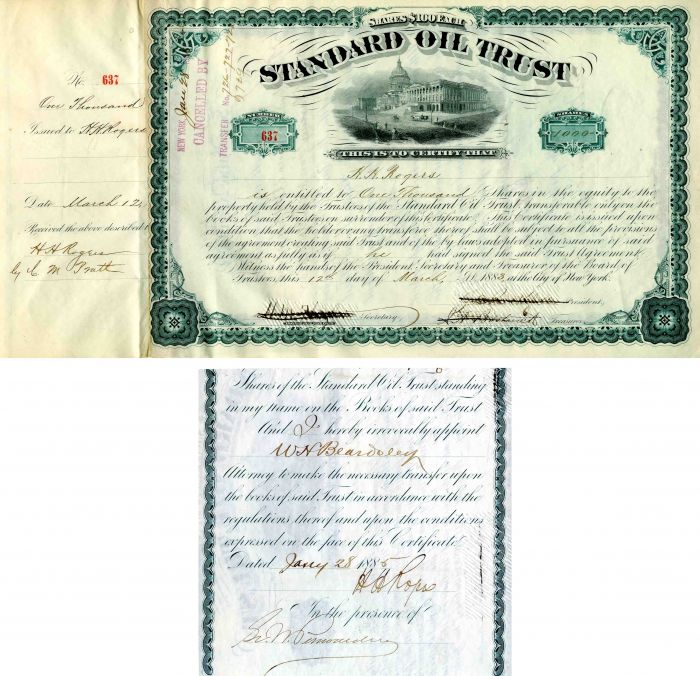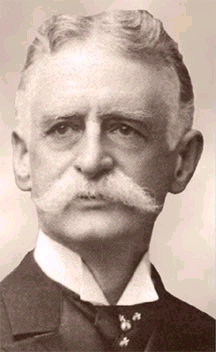Standard Oil Trust Issued to and signed by H.H. Rogers - Stock Certificate
Inv# AG2319 Stock
Stock issued to and signed on back by H.H. Rogers and W.H. Beardsley. Also signed by H.M. Flagler and J.D. Rockefeller. 1,000 Shares! Rare!

Henry Huttleston Rogers (1840-1909) was born into a working-class family in Mattapoisett, Mass. He was the son of Rowland Rogers and Mary Eldredge Huttleston Rogers. Both parents had roots back to the pilgrims, who arrived in the 17th century aboard the Mayflower. His mother's family earlier had used the spelling "Huddleston" rather than "Huttleston," and Henry Rogers' name is often misspelled using this earlier version.
In 1861, 21-year-old Henry pooled his savings of approximately $600 with a friend, Charles P. Ellis. They set out to western Pennsylvania and its newly discovered oil fields. Borrowing another $600, the young partners began a small refinery at McClintocksville near Oil City. They named their new enterprise Wamsutta Oil Refinery.
In 1870, John D. Rockefeller formed Standard Oil Company of Ohio and started his strategy of buying up the competition and consolidating all oil refining under one company. It was during this period that the Pratt and Henry Rogers interests were brought into the fold. By 1878 Standard Oil held about 90% of the refining capacity in the United States.
In the early 1871-72, H. H. Rogers was working for Pratt and Company and other refiners became involved in a conflict with John D. Rockefeller, Samuel Andrews, and Henry M. Flagler and the infamous South Improvement Company. South Improvement was basically a scheme to obtain secret favorable net rates from Tom Scott of the Pennsylvania Railroad and other railroads through secret rebates. The unfairness of the scheme outraged many independent oil producers and owners of refineries far and new alike.
His final business achievement, working with partner William Nelson Page, was the building of the Virginian Railway from the coal fields of southern West Virginia to port near Norfolk at Sewell's Point, Virginia, in the harbor of Hampton Roads. For many years, it was labeled both an engineering marvel and the "richest little railroad in the world," forming part of today's rail network for Norfolk Southern.
While considered ruthless in business matters, Henry Rogers also had a much kinder and generous side. His hometown of Fairhaven, Massachusetts continues to enjoy his many infrastructure gifts. Rogers' late life friendships included such diverse persons as Mark Twain, Ida Tarbell, Helen Keller, and Booker T. Washington.
Rogers was a low-profile philanthropist with a widely hated public image as a robber baron. It was only after his death in 1909 that Dr. Washington felt he could publicly reveal that, over a period of more than 15 years, Henry Rogers had been funding over 65 small country schools and several larger institutions in the South for the betterment and education of African Americans. Dr. Washington not only credited Rogers with substantial aid and encouragement, but with instituting the then-innovative procedure of matching funds. Rogers felt that as well as extending the financial reach, their participation contributed to the beneficiaries' self-esteem and steps to self-sufficiency.
He was listed in a 1996 study as one of the 25 all-time most wealthy individuals in United States history.

Henry Morrison Flagler (1830-1913) Through the grain and distillery business, he met John D. Rockefeller, in Bellevue, Ohio. After a business disaster as a salt manufacturer in Saginaw, Michigan, he moved to Cleveland and soon joined Rockefeller and chemist and inventor Samuel Andrews in forming Rockefeller, Andrews & Flagler in 1867, which they were soon to develop into Standard Oil. By 1872, it led the American oil refining industry, producing 10,000 barrels per day. In 1877, Standard Oil moved its headquarters to New York City, and Flagler and his family moved there as well. He was joined by Henry H. Rogers, another leader of Standard Oil who also became involved in the development of America's railroads, including those on nearby Staten Island, the Union Pacific Railroad, and later in West Virginia, where he eventually built the remarkable Virginian Railway to transport coal to Hampton Roads, Virginia. Henry Flager's non-Standard Oil interests went in a different direction than Henry Rogers', however, when in 1878, on the advice of his physician, Flagler traveled to Jacksonville, Florida for the winter with his first wife, Mary (née Harkness) Flagler, who was quite ill. Two years after she died in 1881, he married again. Ida Alice (née Shrouds) Flagler had been a caregiver for Mary Flagler. After their wedding, the couple traveled to St. Augustine, Florida. Flagler found the city charming, but the hotel facilities and transportation systems inadequate. He recognized Florida's potential to attract out-of-state visitors. He returned to St. Augustine in 1885 and began construction on the 540-room Hotel Ponce de Leon. Realizing the need for a sound transportation system to support his hotel ventures, Flagler purchased the Jacksonville, St. Augustine and Halifax Railroad, the first railroad in what would become known as the "Flagler System" or the Florida East Coast Railway. Flagler completed the 1150-room Royal Poinciana Hotel on the shores of Lake Worth in Palm Beach and extended his railroad to its service town, West Palm Beach, by 1894. The Royal Poinciana Hotel was at the time the largest wooden structure in the world. Two years later, Flagler built the Palm Beach Inn (renamed The Breakers Hotel in 1901) overlooking the Atlantic Ocean in Palm Beach. Flagler originally intended for West Palm Beach to be the terminus of his railroad system, but during 1894 and 1895, severe freezes hit the area, causing Flagler to rethink his original decision. Sixty miles south, the town today known as Miami was reportedly unharmed by the freeze. To further convince Flagler to continue the railroad to Miami, he was offered land in exchange for laying rail tracks from private landowners, including Julia Tuttle, who ran a trading post on the Miami River, the Florida East Coast Canal and Transportation Company, and the Boston and Florida Atlantic Coast Land Company. Flagler's railroad, renamed the Florida East Coast Railway in 1895, reached Biscayne Bay by 1896. Flagler dredged a channel, built streets, instituted the first water and power systems, and financed the city's first newspaper, The Metropolis. When the city was incorporated in 1896, its citizens wanted to honor the man responsible for its growth by naming it "Flagler". He declined the honor, persuading them to use an old Indian name, "Miami". He became known as the Father of Miami, Florida.

John Davison Rockefeller (1839-1937) Founder and one of the original partners of Standard Oil; Oil industry pioneer; Capitalist. At one time reputedly the world's richest man, Rockefeller began his career in Cleveland, Ohio as a successful merchant, prior to the Civil War. In 1863, he and his partners built a refinery which grew into a business that eventually absorbed many other Cleveland refineries and expanded into Pennsylvania oil fields to become the world's largest refining concern. During this time, he was able to expand his operations while others were failing due the talented people with whom he had surrounded himself, to the efficiency of his operations, and to a variety of what are now considered unscrupulous business practices for which he became famous. In 1870, Rockefeller organized the Standard Oil Company of Ohio in order to improve the efficiency with which his operations were being run. In 1882, in part to streamline operations, and in part to avoid state controls, Rockefeller took a step which had a profound significance for American business by creating the Standard Oil Trust. Under this arrangement, a board of trustees took the stock of both the Standard Oil Company of Ohio and of all of its subsidiaries, and ran the combination through the board's executive committee. By this time, public criticism of Rockefeller and his methods was running at near-fever pitch and, in 1892, the Trust was dissolved by the Ohio Supreme Court. The Trust was divided into some 18-later over 30-corporations before being folded into another holding company, Standard Oil of New Jersey (1899). In 1911, the U.S. Supreme Court ordered this latter company dissolved, declaring that it was "a monopoly in restraint of trade," and thus illegal under the Sherman Anti-Trust Act. By this time Rockefeller had almost completely removed himself from business concerns, and was concentrating solely on his philanthropic projects. While the extent of his philanthropies are too numerous to list, among the most prominent are his founding of the University of Chicago (1889), the Rockefeller Institute for Medical Research (1901), the General Education Board (1902) and the Rockefeller Foundation (1913). It is estimated that Rockefeller gave away some $550 million during his lifetime.
A stock certificate is issued by businesses, usually companies. A stock is part of the permanent finance of a business. Normally, they are never repaid, and the investor can recover his/her money only by selling to another investor. Most stocks, or also called shares, earn dividends, at the business's discretion, depending on how well it has traded. A stockholder or shareholder is a part-owner of the business that issued the stock certificates.









Ebay ID: labarre_galleries